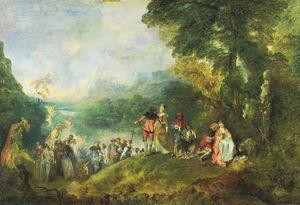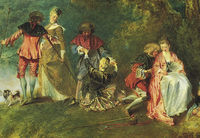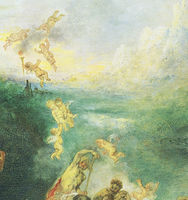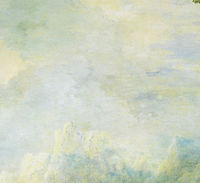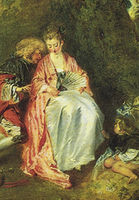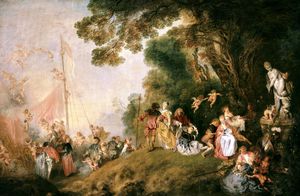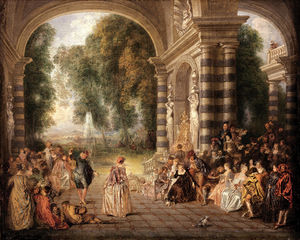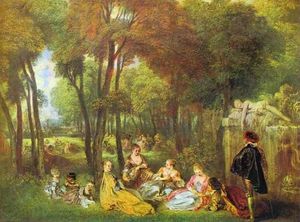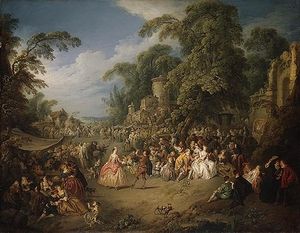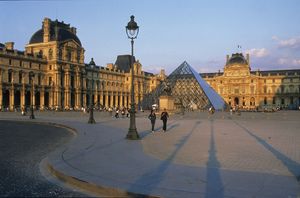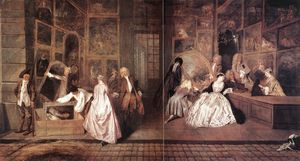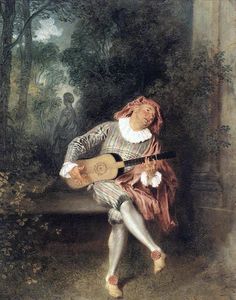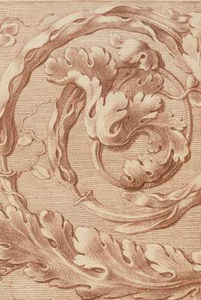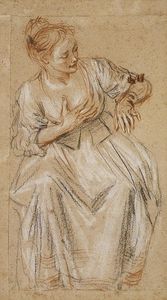Embarkation for Cythera
- Date of Creation:
- 1717
- Alternative Names:
- Pilgrimage to Cythera, Voyage to Cythera, Pilgrimage on the Isle of Cythera
- Height (cm):
- 129.00
- Length (cm):
- 194.00
- Medium:
- Oil
- Support:
- Canvas
- Subject:
- Scenery
- Art Movement:
- Rococo
- Created by:
- Current Location:
- Paris, France
- Displayed at:
- Musée du Louvre
- Owner:
- Musée du Louvre
- Embarkation for Cythera Page's Content
- Story / Theme
- Inspirations for the Work
- Analysis
- Related Paintings
- Locations Through Time - Notable Sales
- Artist
- Art Period
- Bibliography
Embarkation for Cythera Story / Theme
The Embarkation for Cythera is an allegorical love story at its finest. What better place could Watteau have selected for young lovers to go than to Cythera, the beautiful Greek island of love?
Historians still debate whether the pilgrims are on their way to the island or in fact preparing to leave. The majority lean towards their leaving. No matter the location, a group of young couples enjoy another on the densely vegetated island.
The focus falls on three couples in particular who occupy the center right. The sitting couple is absorbed in a flirtatious conversation and the pair standing is preparing to take their place on the boat. The last admirer helps the object of his affection. Other happy couples are boarding the boat. Take note of the cupids hovering about the vessel, they are excited about the lover's journey.
Embarkation for Cythera Inspirations for the Work
Watteau's inspiration for The Embarkation for Cythera culminated from a few different sources. He was inspired by fantastical geographical locations as well as from his beloved theater.
Cythera:
Known as Kithira, in modern Greek, Cythera is a southernmost and easternmost island of the Ionian Islands. It has a mountainous interior, rising to 1,663 feet.
In Antiquity, Cythera was believed to be the birthplace of Aphrodite - Greek goddess of love - and thus became known as the Isle of Love. Watteau's portrayal of Cythera is perhaps the best deception the most vivid imagination could conjure up.
His is an island of love, a paradise decorated with brightly colored landscapes that would enchant even the most plutonic friends to accept the invitation of love. Cupids can be seen flying over the boat, though their services may not be needed as nature does the flirting and mesmerizing quite effectively.
Les Trois Cousines:
This was a prose play by French comedy and tragedy playwright Florent Dancourt and it may have been an inspiration for The Embarkation for Cythera as a group of youths disguised as pilgrims of love prepare for a voyage to Cythera in the finale.
Yet this may be the only similarity to Watteau's painting - Dancourt's sarcastic parody would be a spotty reflection of Watteau's happy and hazy dream.
La Ventienne:
Houdar de la Motte's opera ballet seems a more likely inspiration for The Embarkation for Cythera as it featured stock characters of the Commedia dell'Arte and other pilgrims who accepted the invitation to the island of love. Watteau pursued both of these themes.
Embarkation for Cythera Analysis
In his famous reception piece for the Academie, Watteau shocked the judges with his original style. His revival of colors reminiscent to earlier centuries and the lighting of his piece were particularly striking.
Composition:
All elements of The Embarkation for Cythera are in a head-on perspective. Watteau employs certain techniques to ensure that the viewer looks at his entire composition. The progression of the pilgrims returning to the boat draws attention to the three main couples in the center, who in a lover's trance, lost track of time.
Viewers then glance upward as the space of the canvas is filled with a hazy sky that only Watteau could produce. From there, the viewer is enamored by a beautiful landscape as the clouds bring the focus downward.
Tone:
The theme of this piece cannot help but bring about a happy, peaceful mood. There is no sign of anguish, broken hearts or turmoil in any capacity. Instead, lovers prance around together and cupids fly overhead.
Clearly, Watteau intended The Embarkation for Cythera to give the notion of a fine fantasy.
Brushstrokes:
Watteau was known for using a light and airy brushstroke to create his hazy dream-like atmospheres. This is particularly evident in the wispy clouds and lazy leaves.
Color Palette:
The landscape's bright palette echoes that of 16th century Venetian paintings. The neutral palette of the landscape is complemented nicely by the pastels of the lover's costumes.
Lighting:
The lighting cast in this dream plays up the bright colors of the character's clothing. The center of the canvas lights up the three main couples and the shadows retreat to play in the trees so less attention is paid to other characters.
Embarkation for Cythera Related Paintings
Embarkation for Cythera Locations Through Time - Notable Sales
Embarkation for Cythera Artist
Jean-Antoine Watteau's Embarkation for Cythera caused a major reaction after its completion in 1717. Centuries later art critics are still focusing on Watteau's work.
Proof that Watteau still draws the interest of modern day art critics can be seen in the many recently published books whose contents are in complete dedication to his work.
Such positive reflections can be read in Jed Perl's 2008 publication, Antoine's Alphabet: Watteau and His World. The admiration doesn't stop there. Acclaimed British art historian, Sir Michael Levey, said "Watteau created, unwittingly, the concept of the individualist artist loyal to himself, and himself alone."
Watteau's Embarkation for Cythera received probably the best reaction any artist could dream of, especially a young, undiscovered one.
The judges of the Academy judging his reception piece were shocked by what they saw - Watteau's chromatic theatrical universe. They were pleasantly delighted, conjuring up the inspired title "fétes galantes" (lively, gallant party) and accepting Watteau under this new genre. They felt he truly was in a category of his own.
Jean-Antoine Watteau is attributed to extending the bounds of 18th century French-born artistic period Rococo, beyond architecture, furniture and sculpture and into painting. He developed a unique style and revolutionized the art world through his individuality. This was seen not only in the themes of his work (very theatrically influenced) but also in his style (ornate, airy).
Embarkation for Cythera Art Period
Watteau was a key player in the 18th century Rococo art movement. The word Rococo is a combination of the French rocaille, or shell, due to the heavy usage of shell-like curves, and the Italian barocco, or Baroque style for its decorative nature.
Its style emergence was first displayed in the decorative arts and interior design before Watteau adapted it toward painting aesthetics. Louis XV's succession brought a change in the court artists and general artistic fashion.
By the end of the old king's reign, rich Baroque designs were giving way to lighter elements with more curves and natural patterns. These elements are obvious in the architectural designs of Nicolas Pineau.
During the Régence, court life moved away from Versailles and this artistic change became well established, first in the royal palace and then throughout French high society. The delicacy and playfulness of Rococo designs is often seen as perfectly in tune with the excesses of Louis XV's regime.
Rococo painting, as well as most French art of the 18th century was light, airy, frilly and bejeweled, which is fitting as it was intended for the powerful aristocracy and wealthy upper-middle class.
Watteau's artistic content could be summarized by two major influences: his love for the theater and his fascination of the Rococo styling and design.
Spending his early years in Paris in the workshop of set designer Claude Gillot, Watteau gained his love for the theater, specifically for the Italian Commedia dell'Arte and its innumerable characters. Shortly after, he worked for interior designer Claude Audran III and picked up Rococo design influences.
Watteau's attraction to Rococo's curving lines and decorative nature became central to his later work. As his career progressed the artist combined his love for the theater and his fascination of the Rococo styling and design and developed a truly unique style of painting with ornate elegance that gained him critical attention.
Embarkation for Cythera Bibliography
To find out more about Watteau and his works please choose from the following recommended sources.
• Lauterbach, Iris. Antoine Watteau: 1684-1721. PLACE, 2008
• Mollett, John William. Watteau. Kessinger Publishing, LLC, 2007
• Perl, Jed. Antoine's Alphabet: Watteau and His World. Random House, 2008
• Posner, Donald. Antoine Watteau. Cornell University Press, 1984
• Rogers, Robert Emmons. Behind A Watteau Picture: A Fantasy in Verse in One Act. Kessinger Publishing, LLC, 2007
• Sheriff, Mary D. Antoine Watteau: Perspectives on the Artist and the Culture of His Time. University of Delaware Press, 2006
• Stranahan, C. H. A History of French Painting From the Earliest To Its Latest Practice. Charles Scribner's Sons, 1918
• Zeri, Federico. Watteau: The Embarkation for Cythera. NDE Publishing, 2000

